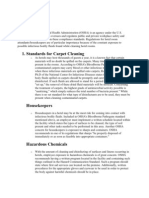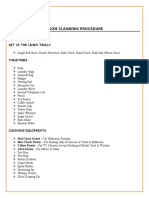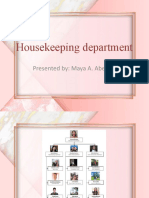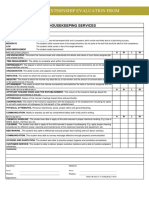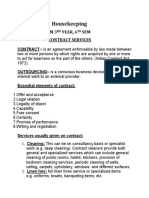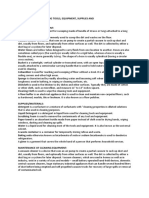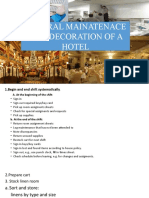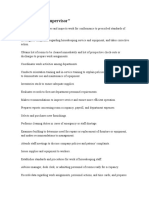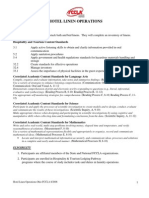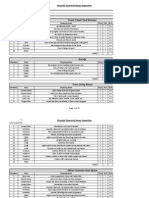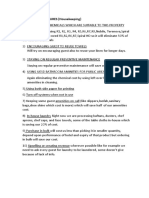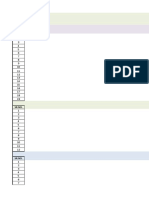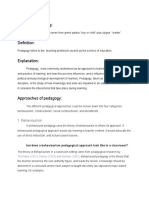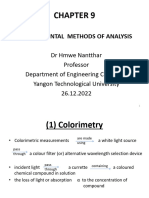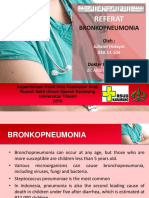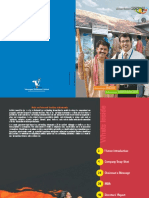Professional Documents
Culture Documents
Safety in Housekeeping Department
Safety in Housekeeping Department
Uploaded by
Laurie RapadasOriginal Description:
Copyright
Available Formats
Share this document
Did you find this document useful?
Is this content inappropriate?
Report this DocumentCopyright:
Available Formats
Safety in Housekeeping Department
Safety in Housekeeping Department
Uploaded by
Laurie RapadasCopyright:
Available Formats
SAFETY IN HOUSEKEEPING HANDLING CHEMICALS SAFELY
DEPARTMENT
You are using cleaning chemicals in
Safety ensures quality for everyone! your job as a housekeeper. When used
safely, they make your job easier and more
MOVING SAFELY is a key factor in efficient. When used in an unsafe manner,
practicing safe work habits. they put you, your co-worker, the hotel, and
the guests in jeopardy. Knowing about the
Will help prevent slips, falls, muscle
chemicals you use will help.
injuries and bruises.
By forming HABITS, you can move GUIDELINES FOR HANDLING
safely and stay healthy CHEMICALS SAFELY
Safe work methods protect the “GUEST” Read container labels and follow
directions
Prevents injury
Make sure containers are not leaking
Makes guests feel comfortable, safe
or damaged
and secure
Be sure chemicals are labeled
Protects guests from incurring added
correctly
expenses should they get hurt
Wear personal equipment such as
(hospital, doctor and medicine bills)
mask, gloves, or goggles when needed
Safe work methods protect “YOU” Do not mix chemicals
Do not sniff contents of containers
Protects body from injury or germs
Protects you from losing hard-earned GUIDELINES FOR PREVENTING EXPOSURE
money due to absence or illness. TO GERMS
Prevents you from practicing bad work
Use different cloths for different
habits that can lead to guest
surfaces
complaining about you
Wear gloves to protect yourself from
Poor work, no recognition, no
contamination
recommendation
Report problems such as blood, urine,
Makes your work easier and more
or other body fluids in the guest room
efficient
Handle soiled linens as little as
Safe work methods protect the “HOTEL” possible
Use disinfectant solution after
Loss of valued employee contributors handling contaminated materials
Loss or damage furnishings
Shorter life of equipment THE MAID’S CART
GUIDELINES FOR MOVING SAFELY: It is a trolley meant to stock a given
number of linen item, supplies and
1. Watch where you are going equipment to service an allotted number of
2. Turn on lights rooms. Each maid after receiving her room
3. Look before entering the room assignment should check her supplies
4. Lift safely by bending at the knees, against a standard list to avoid needless
holding the load close to your body, trips. The maid is responsible for the
and keeping your back straight condition, cleanliness and appearance of the
5. Ask for assistance if a load is to heavy cart.
for you
6. Clean up or immediately report any The lower shelf of the cart is used to
potential safety hazard. carry heavier items like mattresses,
protectors and bed sheets and night spreads.
The mobile and top shelf stock pillow slips an
bath linen.
The linen should include: OTHER HOUSEKEEPING KNOWLEDGE
1. Night spreads (1 for each BED) LAUNDRY SERVICE (Whether in-house or
2. Sheets (2 for each BED) outside)
3. Pillow cases (2 for each BED)
4. Bath towels (1 for each GUEST) Relationship between housekeeping
5. Face towels (1 for each GUEST) and laundry is very significant for the
6. Hand towels (1 for each GUEST) smooth functioning of housekeeping
7. Bath mats (1 for each services. The importance of laundry is
BATHROOM) inevitable as IT PROCESSES SOILED LINEN
8. Mattress protectors AND UNIFORMS AND SUPPLIES
(replacement) HOUSEKEEPERS WITH CLEAN STOCKS ON A
DAILY BASIS TO MAINTAIN HIGH
These terms should be arranged in STANDARDS OF HOUSEKEEPING. It is thus
neat stacks, the heavier items below and the important for housekeeping personnel to
lighter items on top. know something of the operations of the
laundry to fully understand its importance
The top tray should be neatly and contributions.
arranged with the following guestroom
supplies and cleaning agents: VALET SERVICE
VALET RUNNER: for laundry
ROOM:
Primary role of laundry is to PROVIDE VALET
TUMBLER SERVICE TO HOUSE GUESTS. A valet is the
one who, on call, fetches soiled clothes from
SERVICE DIRECTORY
guestrooms and returns them either washed
“DO NOT DISTURB” CARDS or dry-cleaned as per the guest demands.
GUEST STATIONERY LAUNDRY PROCESS
BALL POINT PENS Sorting and Marking
Washing/Dry-cleaning
TELEGRAPH FORMS Hydro-extraction/Tumbler
Ironing
BIBLES/GITA
FOUR TYPES OF PRESS
BATHROOM:
HOT HEAD PRESS
GARGLE TUMBLERS Where two flat surfaces press the
garments. Both surfaces are hot
SHOE MITTS
STEAM PRESS
SOAPS/SOAP DISH Same principles as the hot head
press except that the surfaces
TOILET ROLLS have perforations through which
steam passes.
TOILET TISSUES SHIRT PRESS
BLADE DISPENSERS Special press to give gent’s
shirts then proper contours and
SHOWER CAPS creases specially sleeves,
shoulders and collars.
HAND PRESS
Common domestic press used
for light garments and linens.
OTHER INFORMATION ON LAUNDRY Today soap is made by the
contribution of fatty acid and
What has to be laundered alkalis at different temperatures
What is used in laundering o A GOOD SOAP IS
o Water soaps, detergents and LAUNDERING SHOULD HAVE
alkaline THE FOLLOWING
How laundering is carried out PROPERTIES:
o Washing processes, starch and Good washing power
associated treatments. (DETERGENCY)
Ease of rinsing
WHAT HAS TO BE LAUNDERED? Easy solubility and purity
Textile fibres may be classified in SYNTHETIC DETERGENTS
three categories o The main advantage of using
soap in laundering is that, it is
VEGETABLE FIBRE killed by hard water. It is
o Have their origin in some form sensitive to acids and to salts.
of plant life. Cotton, Linen and Careful attention in rinsing is
Jute. required in order that no traces
ANIMAL FIBRE of soap are retained in t he
o Have their origin from animals fabric. Detergents give more
SYNTHETIC OR MAN-MADE efficient performances in hard
o Nylon, Dacron, Terylene water are easily soluble and are
easily rinsed from fabric. They
WHAT IS USED IN LAUNDERING? can be used with the builders or
alkalis.
WATER WASHING PROCESSES
o It is the most important o Wetting-out
material in laundering not only o Soil removal
because of the large amount o Soil suspension
required but also because the o Removal of soil from the
success or failure of the
machine
washing process depends upon
the suitability of water supply. FIRE PREVENTION
HARDNESS OF WATER
o TEMPORARY HARDNESS GOOD
Bicarbonate of Calcium HOUSEKEEPING/HOUSEKEEPER
and Magnesium o Important requirement for fire
Can be removed by prevention
boiling (Changed into Falls under maintenance department
carbonates) o Helps prevent hazards
o PERMANENT HARDNESS Achieved through
Sulphates of Calcium and orderliness and
Magnesium elimination of hazards
Which can be removed by CHIEF ENGINEER
chemical treatment o Responsible for fighting fires in
known as WATER hotels
SOFTENING o Responsible for instructing
SOAPS AND DETERGENTS every employee in his
o Known to main from earliest department on organizing and
times when it was customary to supervising fire drills and for
mix the ashes of wood under the maintenance of a well
the cooking pot with rancid fats trained group which acts as a
from the cooking pot itself.
fire patrol as well as fire
fighters.
CLASSIFICATIONS OF FIRES
CLASS A
o Fire occurring in ordinary dry
combustible materials such as
wood, textiles, papers, rubbish,
etc. in these fires, the
quenching and cooling effects of
quantities of water or solutions
containing a high percentage of
water are of full importance.
CLASS B
o Fires in inflammable liquids
such as oils, grease, etc. in
these fires a blanketing effect is
essential.
CLASS C
o Fires in electrical equipment
where the use of non-
conductive agents are required
for extinguishing them.
TYPES OF EXTINGUISHER
1. SODA ACID EXTINGUISHER (Class A)
2. CARBON DIOXIDE FOG (Class B and C)
3. CARBON DIOXIDE FOAM (Class B)
CLASSIFICATION/DISTRIBUTION OF
EXTINGUISHER:
CLASS 1: Light hazard occupancy
1:5000 Sq. Ft.
CLASS 2: Ordinary combustible
1:2500 Sq. Ft.
CLASS 3: Hazardous areas
1:2500 Sq. Ft. plus 1 special
extinguisher for confined areas.
You might also like
- Residential Deep Cleaning ScopeDocument3 pagesResidential Deep Cleaning ScopeAiziel Orense100% (2)
- OSHA Hotel RegulationsDocument10 pagesOSHA Hotel RegulationsJane CarelNo ratings yet
- 11kV Line - WorkDocument4 pages11kV Line - Worksbpathi50% (2)
- Hotel Housekeeping Cleaning Checklist: Clean The Main Living AreaDocument3 pagesHotel Housekeeping Cleaning Checklist: Clean The Main Living AreaSandip SukeNo ratings yet
- Housekeeping Award Checklist PDFDocument3 pagesHousekeeping Award Checklist PDFAdil DarNo ratings yet
- Room Cleaning ProcedureDocument4 pagesRoom Cleaning ProcedureKomal Jagdale100% (3)
- Laundry - An Housekeeper PerspectiveDocument24 pagesLaundry - An Housekeeper Perspectivegrgnolis100% (1)
- Housekeeping Department: Presented By: Maya A. AbergasDocument12 pagesHousekeeping Department: Presented By: Maya A. AbergasKandi ZuenNo ratings yet
- Duty & ResponsibilityDocument8 pagesDuty & ResponsibilitySujay Vikram SinghNo ratings yet
- Housekeeping AssingmentDocument8 pagesHousekeeping AssingmentShakil Ahmad 40BNo ratings yet
- Deep Cleaning ServicesDocument12 pagesDeep Cleaning ServicesHomemitraNo ratings yet
- Cleaning of BathroomDocument24 pagesCleaning of BathroomNakul MohindraNo ratings yet
- Evaluation - HousekeepingDocument1 pageEvaluation - HousekeepingI'm A GrootNo ratings yet
- HSK SopDocument52 pagesHSK SopEsitNo ratings yet
- Housekeeping SOP NEWDocument3 pagesHousekeeping SOP NEWVikram RamakrishnanNo ratings yet
- Food & Beverage: Sheraton Monthly Inventory Front Office / F&BDocument7 pagesFood & Beverage: Sheraton Monthly Inventory Front Office / F&BryanNo ratings yet
- House Keeping 6th SemDocument60 pagesHouse Keeping 6th SemAmit GuptaNo ratings yet
- Guestroom CleaningDocument115 pagesGuestroom CleaningCerpa Ming100% (1)
- The Airbnb Cleaning Handbook: Your Step-By-Step Guide To Airbnb's Enhanced Cleaning ProtocolDocument38 pagesThe Airbnb Cleaning Handbook: Your Step-By-Step Guide To Airbnb's Enhanced Cleaning ProtocolissahandalNo ratings yet
- Types and Uses of Cleaning ToolsDocument3 pagesTypes and Uses of Cleaning ToolsBhem BoyNo ratings yet
- Sales Invoice With Stock Number1Document1 pageSales Invoice With Stock Number1Bojan M. IlicNo ratings yet
- Chapter 12 Housekeeping InventoryDocument16 pagesChapter 12 Housekeeping InventoryAvinashmadhvi Solanki50% (2)
- 04) How To Clean A Room HoutDocument7 pages04) How To Clean A Room HouthanymoussaNo ratings yet
- ActivityDocument39 pagesActivityGracey Aben HernandezNo ratings yet
- Room Checklist - I Made Prahlada Gusti WarmadewaDocument4 pagesRoom Checklist - I Made Prahlada Gusti WarmadewaDedeprahladaNo ratings yet
- Housekeeping DepartmentDocument3 pagesHousekeeping Departmentlloyd toroctoconNo ratings yet
- Housekeeping Practices in Offices, Hospital & MallDocument6 pagesHousekeeping Practices in Offices, Hospital & MallSudarshan MoreNo ratings yet
- 4.d General Maintenance and Decoration of A Hotel (Mary Joy & Amanda)Document22 pages4.d General Maintenance and Decoration of A Hotel (Mary Joy & Amanda)Alliah Dela RosaNo ratings yet
- New Microsoft Word DocumentDocument34 pagesNew Microsoft Word Documentanon-110496No ratings yet
- SOP - Housekeeping - Cleaning Shower Curtain and BathtubDocument1 pageSOP - Housekeeping - Cleaning Shower Curtain and BathtubRaj Meridian Hotel100% (1)
- Turndown Service ProcedureDocument2 pagesTurndown Service ProcedureDarwin BonaobraNo ratings yet
- Chapter 1Document45 pagesChapter 1Amey100% (1)
- Housekeeping SupervisorDocument4 pagesHousekeeping SupervisorAlfonso MelgarNo ratings yet
- Executive Manager Is The Chief of Housekeeping Department. The Deputy Housekeeper andDocument4 pagesExecutive Manager Is The Chief of Housekeeping Department. The Deputy Housekeeper andRenz KunNo ratings yet
- Presentation 1Document11 pagesPresentation 1Daniel Jadol100% (1)
- Hotel Linen Operations FinalDocument6 pagesHotel Linen Operations Finaltivursio29No ratings yet
- HOTEL LaundryDocument46 pagesHOTEL LaundrykomalNo ratings yet
- Budgeting For Housekeeping Expenses.: Executive HousekeeperDocument24 pagesBudgeting For Housekeeping Expenses.: Executive HousekeeperHawacom Resources100% (1)
- Duties Floor SupervisorDocument15 pagesDuties Floor SupervisorShaGun ChNo ratings yet
- HK Supervisor - Room - Inspection - ChecklistDocument2 pagesHK Supervisor - Room - Inspection - ChecklistRitesh SinghNo ratings yet
- Sop For Housekeeping DepartmentDocument2 pagesSop For Housekeeping DepartmentANGELOU SAGARAL100% (1)
- Room CleaningDocument29 pagesRoom CleaningYusri YopNo ratings yet
- Updated Ogden House Inspections Revised 02 01 2014Document56 pagesUpdated Ogden House Inspections Revised 02 01 2014api-250565373100% (1)
- Housekeeping Assessment TestDocument4 pagesHousekeeping Assessment TestLaw- TrackNo ratings yet
- Cost Control MeasuresDocument2 pagesCost Control MeasuresKapil NaikNo ratings yet
- HOUSEKEEPING ASSIGNMENT SipDocument17 pagesHOUSEKEEPING ASSIGNMENT SipRohan Sharma100% (1)
- Linen and Laundry StaffDocument6 pagesLinen and Laundry StaffFlordelis Blanco LisaoNo ratings yet
- Towel Folding Booklet UpdatedDocument6 pagesTowel Folding Booklet Updatedika.ja45No ratings yet
- Layout of HKDocument33 pagesLayout of HKNanjappa BabuNo ratings yet
- Key Laundry Tips: Proposed Guidance MatrixDocument3 pagesKey Laundry Tips: Proposed Guidance MatrixjayNo ratings yet
- HK SopDocument26 pagesHK SopchaitravipNo ratings yet
- Sample Linen ManagementDocument109 pagesSample Linen ManagementRichard Allan Soliven100% (2)
- Housekeeping ScheduleDocument4 pagesHousekeeping SchedulefaizforuNo ratings yet
- LINEN Housekeeping DepartmentDocument14 pagesLINEN Housekeeping DepartmentpranithNo ratings yet
- Housekeeping Operating ManualDocument69 pagesHousekeeping Operating ManualKartiman KtmNo ratings yet
- House Keeping at Apeejay Hotel Bagalore: Project Report OnDocument85 pagesHouse Keeping at Apeejay Hotel Bagalore: Project Report Onaccord123100% (2)
- HK Cleaning ChemicalsDocument2 pagesHK Cleaning ChemicalssaadNo ratings yet
- Staffing and SchedulingDocument29 pagesStaffing and SchedulingNikita PandeyNo ratings yet
- Peter-Tobias Stoll, Jan Busche, Karen Arend - WTO-Trade-related Aspects of Intellectual Property Rights (Max Planck Commentaries On World Trade Law) (2009)Document945 pagesPeter-Tobias Stoll, Jan Busche, Karen Arend - WTO-Trade-related Aspects of Intellectual Property Rights (Max Planck Commentaries On World Trade Law) (2009)Ada HajnajNo ratings yet
- ATMS DRESS CODE POLICY Poster FinalDocument1 pageATMS DRESS CODE POLICY Poster FinalZahraNo ratings yet
- Full Chapter Artistic Migration Reframing Post War Italian Art Architecture and Design in Brazil 1St Edition Aline Coelho Sanches PDFDocument53 pagesFull Chapter Artistic Migration Reframing Post War Italian Art Architecture and Design in Brazil 1St Edition Aline Coelho Sanches PDFkaren.inda786100% (7)
- Selective MediaDocument10 pagesSelective Mediaprincess_likemist4No ratings yet
- Thesis: Mapping YourDocument386 pagesThesis: Mapping YourKEREM ORKUNNo ratings yet
- Boeing Multi-Operator Message MOM-MOM-19-0623-01B, Dated November 5, 2019Document21 pagesBoeing Multi-Operator Message MOM-MOM-19-0623-01B, Dated November 5, 2019Alex Cruz0% (1)
- Brochure BAADER 604 English 2021Document4 pagesBrochure BAADER 604 English 2021احمد سعيدNo ratings yet
- Alternate Futures For 2020 (1994)Document24 pagesAlternate Futures For 2020 (1994)Moss3113No ratings yet
- WT2 IdcDocument17 pagesWT2 IdcYzifarNo ratings yet
- Pedagogy NotesDocument4 pagesPedagogy NotesZain Ul AbideenNo ratings yet
- Arkansas Public Transportation FundingDocument86 pagesArkansas Public Transportation FundingMadison HardcastleNo ratings yet
- Complexometric Titration of ZincDocument1 pageComplexometric Titration of ZincMireliz Corilloclla100% (1)
- SQP 20 Sets Physical EducationDocument81 pagesSQP 20 Sets Physical EducationRamesh Pearl Enterprises100% (1)
- Chap9 PDFDocument144 pagesChap9 PDFSwe Zin Zaw MyintNo ratings yet
- Referat Bronkopneumonia JulDocument18 pagesReferat Bronkopneumonia Juljuliand hidayat100% (1)
- Chemical Kinetics (M) PDFDocument41 pagesChemical Kinetics (M) PDFNalla Umapathi Reddy75% (4)
- Law in PartnershipDocument15 pagesLaw in Partnershipmelody agravanteNo ratings yet
- SOS-Saving Our Sight: Safety EyewearDocument3 pagesSOS-Saving Our Sight: Safety EyewearSantos RexNo ratings yet
- AR07449 FloTrac Vig SetupGuide 1212aLRiPDocument2 pagesAR07449 FloTrac Vig SetupGuide 1212aLRiPandany0117No ratings yet
- Unit 4Document64 pagesUnit 4nagaNo ratings yet
- The Various Trusses For Hip Roof SystemsDocument2 pagesThe Various Trusses For Hip Roof SystemsDaryl BallesterosNo ratings yet
- Synthesis of Schiff Base Ligand Using 2 - 1Document6 pagesSynthesis of Schiff Base Ligand Using 2 - 1AHLBAIT TVNo ratings yet
- Did Someone Say ParticipateDocument2 pagesDid Someone Say ParticipateAkansha RastogiNo ratings yet
- Manual Receptor Universal 2 CanalesDocument2 pagesManual Receptor Universal 2 CanalesJabier Tres ENo ratings yet
- Brother MFC9440CN Parts ManualDocument43 pagesBrother MFC9440CN Parts Manualjujubeadshead100% (1)
- NTLNG in Nglish: How Givesuccessful PresentationsDocument5 pagesNTLNG in Nglish: How Givesuccessful PresentationsTrần Thanh KhiếtNo ratings yet
- Modulo Rele Asi Safety - BWU2045Document5 pagesModulo Rele Asi Safety - BWU2045DenisNo ratings yet
- Yaris: Exhaust Pipe FinisherDocument4 pagesYaris: Exhaust Pipe Finisherbatto1No ratings yet
- India Vakrangee: Annualreport Annualreport AnnualreportDocument128 pagesIndia Vakrangee: Annualreport Annualreport AnnualreportIosiasNo ratings yet

